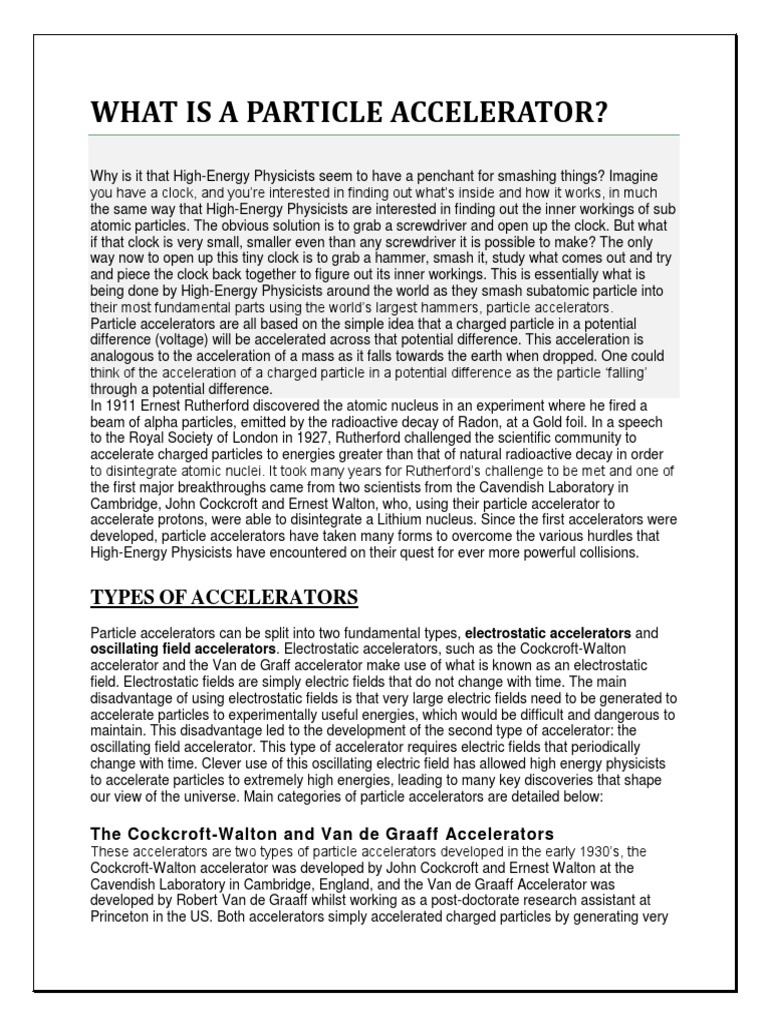Particle accelerators are quintessential instruments in modern physics, enabling the exploration of fundamental questions about the universe. These sophisticated machines propel charged particles to high velocities, facilitating collisions at energies that replicate conditions just after the Big Bang. The utility of particle accelerators transcends mere academic inquiry, impacting diverse fields such as medicine, industry, and fundamental science.
One of the primary applications of particle accelerators lies in high-energy physics. At facilities like the Large Hadron Collider (LHC) at CERN, accelerators create conditions similar to those present in the early universe. By colliding protons at unprecedented energies, physicists investigate the fundamental components of matter, delve into the mechanisms behind electromagnetic forces, and even confront enigmatic phenomena such as dark matter and energy. The LHC famously contributed to the discovery of the Higgs boson, a pivotal particle that confers mass to other particles. Such breakthrough research is not merely theoretical; it holds the potential to revolutionize our understanding of the cosmos.
In addition to high-energy physics, particle accelerators play an indispensable role in the field of medical therapy, particularly in cancer treatment. Particle beam therapy, notably proton therapy and heavy ion therapy, has emerged as an effective cancer treatment modality. Unlike conventional X-ray radiation, which can cause significant damage to surrounding healthy tissues, these charged particles target tumors with remarkable precision. The Bragg peak phenomenon, wherein particles deposit most of their energy directly at the tumor site, minimizes collateral damage, leading to better patient outcomes. Hospitals worldwide are increasingly investing in particle accelerator technology to enhance their cancer treatment capabilities.
Moreover, accelerators are pivotal in the production of medical isotopes required for various diagnostic and therapeutic procedures. For instance, positron emission tomography (PET) scans rely on isotopes produced via nuclear reactions facilitated by accelerators. When certain isotopes decay, they emit positrons, which collide with electrons, resulting in the emission of gamma rays that are detectable by PET scanners. This imaging technique has become indispensable in oncology, cardiology, and neurology as it allows for the visualization of metabolic processes in the body.
The applications of particle accelerators extend beyond healthcare into materials science and industry. Accelerators are employed to modify materials’ properties through techniques such as ion implantation. This process involves bombarding a substrate with accelerated ions, altering its physical and chemical properties, thus enhancing its functionality. For instance, semiconductor fabrication relies heavily on ion implantation to engineer electronic devices with the desired conductivity. Furthermore, accelerators facilitate advanced materials analysis through techniques like X-ray diffraction and electron beam melting, providing insights into microstructure and phase composition.
One cannot overlook the significance of particle accelerators in the realm of fundamental scientific research, especially in the study of rare processes and the behavior of particles under extreme conditions. Unique experiments at synchrotrons probe the nuances of atomic and molecular structures, unveiling the intricacies of chemical reactions and phase transitions. These insights not only deepen our understanding of basic scientific principles but also have far-reaching implications for developing new materials and technologies.
Accelerators also serve an educational purpose, fostering public engagement and promoting STEM (Science, Technology, Engineering, and Mathematics) initiatives. Many institutions hosting particle accelerators offer guided tours, workshops, and outreach programs that elucidate the principles of particle physics and the significance of their research. Such initiatives inspire future generations to pursue careers in science and engineering, thereby cultivating a more informed and scientifically literate society.
Despite their numerous advantages, the construction and operation of particle accelerators do entail considerable financial and logistical challenges. Funding for such monumental projects often involves international collaboration, pooling resources from various nations and institutions. The scientific community must justify expenses with demonstrable outcomes that contribute to knowledge and societal benefits. Moreover, given the scale of these machines, their construction can span several years or even decades, requiring sustained commitment and collaboration amongst a global network of researchers.
The future of particle accelerator technology looks promising, with advancements beckoning on the horizon. Novel concepts such as plasma wakefield acceleration show potential for producing high-energy particles in significantly shorter distances than traditional methods, which could democratize access to particle physics research. Furthermore, research into compact accelerators aims to make this technology more portable and less expensive, enabling broader applications in both science and industry.
In conclusion, particle accelerators are not merely tools for probing the minutiae of particle interactions; they are catalysts for progress across a multitude of domains. From unraveling the mysteries of the universe to enhancing medical treatments and advancing industrial applications, their multifaceted uses highlight their quintessential role in contemporary science and technology. As research evolves and new technologies emerge, the scope and impact of particle accelerators are poised to expand, continuously reshaping our understanding of nature and our capacity to harness its underlying forces.












